WHY CAN’T IT ALWAYS BE OCTOBER?
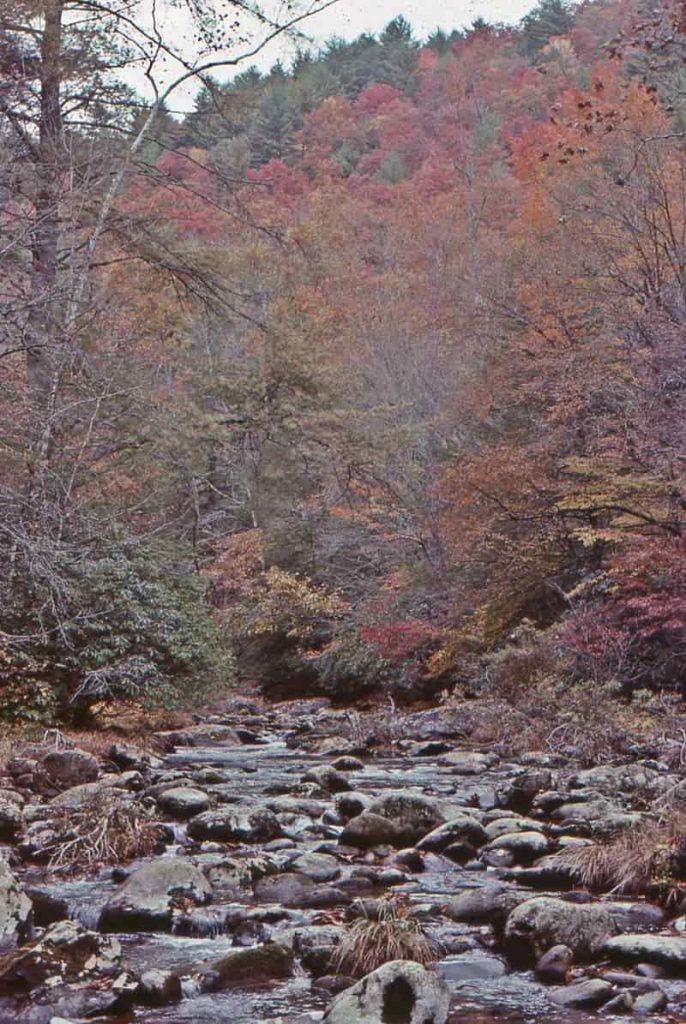
Big Santeetlah Creek in its autumnal splendor
As the title of this month’s newsletter suggests, I have an ongoing love affair with the month of October. While much the same holds true for May, I reckon when all things are considered in the balance, I have to come down on the side of October. Here are some of the many reasons why I am, and always have been, over the moon about October.
*Mention of the moon brings to the forefront one of the jewels in October’s crown. To see the hunter’s moon ease up from the eastern horizon, glowing orange and seemingly so close you can almost but not quite reach it, is to be touched by magic.Viewing that cold gold just clearing the eastern horizon while one is roaming in the gloaming is an experience which far outpaces my abilities as a writer when it comes to description. Suffice it to say if you don’t feel close to the earth and a bit awestruck under such a moon, I humbly suggest that an appointment, and make it soon, with the nearest qualified psychiatrist is in order.
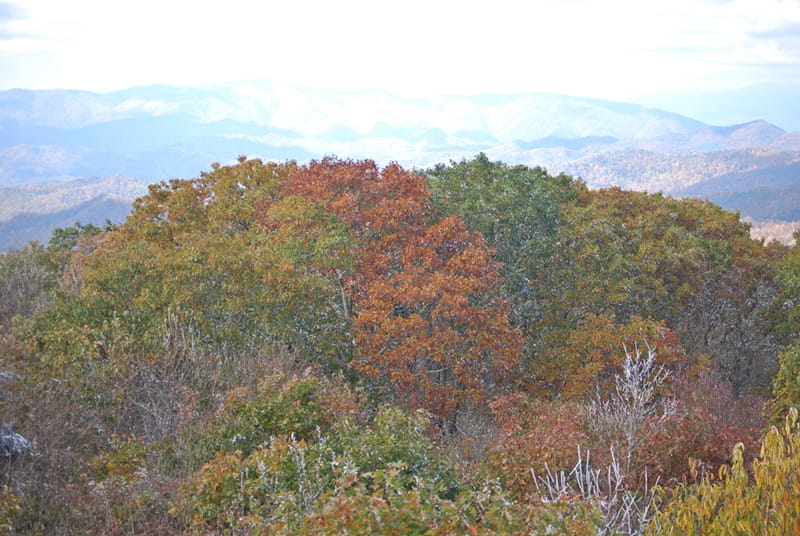
Atop Wayah Bald
*October is the woodlands adorning their fall finery in a matchless array of gold, scarlet, bronze, deep maroon verging on magenta, and colors I could go on to describe in lavish detail if only I was sufficiently gifted as a writer. As things stand, those colors, transitional though they may be, are something better experienced in person than described in print.
*It’s a heavy-racked buck, his neck swollen with lust, feeling all the immense hormonal push of the rut and the eternal drive of procreation.
*It’s a son of the Smokies indulging in mental time travel which takes him back better than half a century to October afternoons which found him rushing home from school. A quick change of clothing, grabbing a big chunk of cornbread and a raw turnip, or maybe a cold sweet tater, his trusty 20 gauge, and he was ready for an afternoon of squirrel hunting. There was magic in those golden woods of October, peace in sitting quietly on a fallen log or against an ancient oak while still hunting, and most of all—time. I was unhurried, unworried, and time seemed a commodity of which I possessed boundless amounts. Looking back, I know just how blessed I was by those days of bliss, and if twilight found me headed homeward with two or three bushytails in my Duxbak vest, so much the better.
*It’s a buck in the prime of his years, full of virility and driven by the ages-old impulse to reproduce. He wanders the woods, neck mightily swollen, as he works scrapes, leaves his scent on limbs, and searches for a doe in estrus.
*It’s a wizened and wise country farmer, a man who has lived on land which has belonged to his family for generations, pursuing the timeless rituals of the harvest—picking the last apples from the farm’s orchard; filling a corn crib with full ears that will fatten hogs and feed chickens that lay eggs that taste far superior to anything ever find on grocery store shelves; gathering pumpkins to make leather, bake into pies, feed raw to the hogs, or carefully store in a root cellar for use in the months to come.
*It’s wrinkles on that patriarch’s face, or maybe they are just character lines, telling a tale of a life well lived.
*It’s October beans drying on standing corn stalks.
*It’s golden persimmons, wrinkling as they ripen and drop to the ground. If you have sufficient gumption you can beat the critters—deer, ‘possums, ‘coons, coyotes, and foxes—to this candy from nature. If that results in a persimmon pudding, consider yourself rich beyond any amount which ever appeared on a bank statement.
*It’s molasses fresh in the can or jar, mere weeks from the pressing but full of promise atop breakfast biscuits for months to come.
*It’s another season of honey duly taken from hives and stored for satisfaction of even the hungriest of sweet teeth.
*It’s an old man and a young boy, one carrying a single-shot .22 and the other an old hammer shotgun, heading to woods marked by that sentinel of autumn, hickory trees clad in cloaks of gold, for a day of squirrel hunting.
*October is table fare from the product of such a hunt, squirrel and dumplings with recently dug sweet potatoes flanking one side of the platter and a heaping mess of turnip greens cooked with diced young turnips and streaked meat on the other. Add cathead biscuits and a big gravy boat full to the brim with squirrel gravy and you have a meal of the sort royalty is seldom privileged to sample and savor.
*October is, in short, a grand time to be alive. It puts pep in an old man’s step and fills youngsters with inexpressible joy. It’s the cycle of another season of growth winding down to a frost-bedecked conclusion, but that doesn’t translate to sadness. Rather, it calls for celebration of another harvest, the arrival of another hunting season, and thankfulness for all the many blessings to be derived from life lived close to the earth.
**********************************************************************************
JIM’S DOIN’S
Recent weeks have been busy ones for me. After a sort of practice run before Friends of the Bryson City Cemetery, on September 20 I delivered the keynote address to the annual members’ meeting of the Great Smoky Mountains Association (GSMA) in Gatlinburg. My presentation was on four early photographers—George Masa, Albert “Dutch” Roth, Jim Thompson, and “Doc” Kelly Bennett–who captured scenes in the Smokies in the decades prior to the actual creation of the Park. It was well-received and my brother, Don, had put together a stellar grouping of slides, some accompanied by music from Dolly Parton and Mel Street, to accompany my words. The only let-down was a screen which was far too small to do the slides justice, and I fear some of those in the back of a capacious room felt they were looking at a miniature television.
There was the eternal joy of being in my beloved Smokies for a day or two, having the opportunity to eat supper and chat some with not only my brother and his oldest son, Josh, but to also have longtime friend and Smokies expert Ken Wise join us. Then I finally got to meet, after countless e-mail exchanges, fellow writer and historian Dan Pierce, and I also chatted with a bunch of the folks who work for the GSMA. A nice side benefit was coming away from the event with an assignment to write a story on Mark Cathey, one of the grand and intriguing characters of the Smokies of yesteryear, for the GSMA’s magazine, Smokies Life.
On other fronts I just finished up a profile of Wiley Oakley, who was in many senses the progenitor of Gatlinburg, TN and, like Cathey, a delightfully intriguing individual. It will appear in Smoky Mountain Living, and the current issue of the same magazine contains my profile of a wonderful African-American woman from my early boyhood, “Aunt Mag” (Maggie Williams). The current issue of another mountain-based publication, Carolina Mountain Life, includes my piece on “Yard Birds,” reminiscing on chickens and other domestic fowl as they once figured in mountain life.
This is the season of outdoor writer gatherings, and I just returned from a dandy event for the South Carolina Outdoor Press Association (SCOPe) which was held down in the Santee-Cooper region at Black’s Camp in Cross, SC (www.blackscamp.com) and hosted by Santee Cooper Country (www.santeecoopercountry.org) and various other entities such as the Clarendon County Chamber of Commerce (www.chamber@clarendoncounty.com), Berkeley County (www.BerkeleyMeansBusiness.com) and The Clarendon Club (contact owner/operator Whitney Phillips at 803-460-9379 or by e-mail at clarendon.club@outlook.com). All these fine folks represent the quintessence of Southern hospitality and you can experience the Palmetto woods and waters at prices ranging from inexpensive and down-to-earth to the lap of luxury.
There’s exceptional deer and duck hunting through the Clarendon Club and other operations. As for the fishing, the two lakes (Marion and Moultrie) making up the Santee-Cooper complex are famed for a reason. They offer some of the finest angling opportunities for largemouth bass, striped bass, catfish, and panfish you will find anywhere. While I was able to attend only the final day and a half of the gathering, fellow outdoor writers from S. C. and Georgia had a ball fishing along with hunting for deer and other outdoor activities.
Look at it any way you wish, but it’s a truly grand region for the outdoorsman. Whether you are looking for the makings of a scrumptious catfish stew or maybe some venison backstraps stuffed with creamy cheese, wrapped in bacon, and grilled to medium-rare perfection, I strongly recommend contacting these folks using the various contact information which appears above. You can readily find something to fit all budgets and sporting tastes from the basic to the exquisite.
The meeting was gratifying for me in a whole bunch of ways. It’s always a pleasure to share stories, exchange ideas, and sort of recharge batteries through contact with longtime friends who are fellow communicators. Equally enjoyable is meeting and having the opportunity to talk with new folks. I met a number such individuals, both communicators and industry representatives.
Further gratification came from the awards ceremony at our annual awards ceremony where winners of entries in the SCOPe Excellence in Craft competition are recognized. It was a banner year for this old fellow and rewarding in the sense that the awards told me my work is still recognized as worthy by my peers (the judges come from another state organization, the Georgia Outdoor Writers Association). That, in turn, offers incentive and encouragement to continue to produce books and stories (and write this newsletter). Here are winning entries of mine in the categories where I was among the entrants recognized with awards.
Best Outdoor Blog—Third Place for December, 2018 and January, 2019 issues of this newsletter.
Best Magazine Short Article—Second Place for “Sling Shot Memories” in Carolina Mountain Life, Spring, 2019.
Best Electronic Story—First Place for “Of Catfish and a Smelly Old Codger” in “Sporting Classics Daily,” May 24, 2018.
Best Magazine Story Over 1,000 Words—First Place for “I Just Needed to Fish and Find My Soul” in Smoky Mountain Living, June/July, 2018.
Best Newspaper Story—First Place for “October in the Hills” in the Smoky Mountain Times, Oct. 4, 2018.
Best Outdoor Book—First Place for The Greatest Deer Hunting Book Ever.
I’m busy trying to put together a prospectus for another book. I don’t want to say much about it at this juncture, other than to note it will be a joint effort focusing on food, Appalachian food traditions, and the manner in which family and friends have long made earning and enjoying our daily bread one of the hallmarks of regional culture. As the project unfolds and develops, I’ll share more. For now though, suffice to say I’m busy on this and other book projects, and within a week or at most a fortnight of you reading these words things should have been finalized on “A Smokies Boyhood and Beyond: Mountain Musings and Memories.” At present I’m trying to round up vintage photographs to support it. The publication process with academic presses is a slow one, but if all goes well the book will be available roughly a year from now.
That pretty well sums it up. I need to get into the deer woods—and soon. Parts of this were written with temperatures well into the 90s, never mind that fall had arrived, and I’m not so eager to deal with whitetails as to sit in a stand in withering heat. Give me some 60s or 70s though and resting in a likely spot, watching shooting lanes while my mind wanders wherever it wishes, is another story. It’s a sort of current equivalent of doing much the same things six decades ago, with the only real difference being that the quarry was bushytails rather than whitetails.
**********************************************************************************
SEASONAL FOODS AND RECIPES
Thanks in part to the aforementioned dipping my literary toes into another cookbook endeavor, in part to fond memories of grabbing a chunk of cornbread for a snack after school as I headed out squirrel hunting, and simply because I enjoy the satisfying pleasure cornmeal can provide in so many ways, I’ve had it in mind a lot of late. Just last night, for example, I made what Momma always called cornbread pancakes to go with a big pot of pintos cooked with ham and slaw as a side dish. Preparation of the “pancakes” is the essence of simplicity—just make batter as you would for regular cornbread and then cook individual cakes on a griddle rather than baking a pone in the oven.
JIM’S CORNBREAD
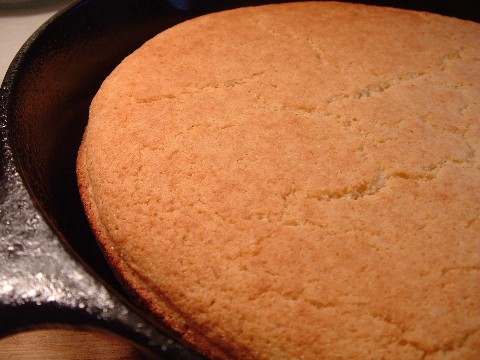
I’m not overly given to measurements, and that is particularly true with something like cornbread. Still, I’ll try to give specifics even as I readily acknowledge measuring devices play a minimal role in my production of cornbread.
2 cups of cornmeal (if at all possible, get stone-ground, slow-ground meal—fast grinding, which is invariably the approach with what you’ll buy in the grocery store, sacrifices flavor for the sake of speed)
Enough buttermilk to make a thick batter (approximately 1½ cups)
1 large or 2 small eggs
Generous measure (3 or 4 tablespoons cooking oil—if you have it, rendered lard, melted, is better)
A pinch of salt (only if the meal is unsalted—that won’t be the case with typical store-bought stuff)
½ teaspoon baking soda
Sift the cornmeal if you wish (I actually like slightly coarse meal, which you typically get when it is stone-ground) then add the other ingredients. Whisk vigorously and thoroughly until creamy. Batter for cornbread should be quite thick.
For a pone, pre-heat a seasoned cast-iron skillet and your oven to 350 degrees. If you make pancakes (or hoe cakes, or Johnny cakes, or whatever you want to call them), grease your griddle, pan, spider, or whatever utensil you use on the stove top and, as with oven cooking, pre-heat it. In either case, cook until done. One of the great advantages of cornbread pancakes is that they are ready in very short order whereas a pone will require 20-30 minutes, depending in part on your oven and in part just how brown and crusty you want it. A disadvantage is that you don’t get the wonderful crisp and crunch crust. My wife used to swear a bit of pone stuck to the pan just so she could eat the crust piping hot straight from the oven. The cast iron pan, slick as an icy sidewalk, argued otherwise. It was far too well seasoned, and she was far too fine a cook, for that to happen. She just wanted an excuse to get at that crust.
Cornbread is open for endless experimentation—adding a bit of flour, infusing tasty morsels such a corn kernels, chopped jalapenos, cheese bits, cottage cheese, and the like, to the batter. Or there’s the pinnacle of the cornbread world, something so fine that it will bring tears of pure culinary joy to a glass eye, cracklin’ cornbread. If you’ve got real cracklin’s, not those pretenders sold by the Philistines who run modern grocery stores, they render something which is already scrumptious a dish of indescribable splendor.
PINTO BEANS
To me, pintos are a sort of comfort food. They’ve been an integral and commonplace part of my diet as long as I can remember. You could count on them being served at least once a week when I was a school boy, thanks no doubt in part to the fact they were one of the more abundant “government surplus” products of the late 1940s and 1950s. We also ate them regularly at home, and that continued when I went off to college. I love properly prepared pintos—they are a gift from the culinary gods and balm for the hungry soul—but cooking them “right” isn’t as simple as you might think.
Pintos without some pork backing them up in the cooking process are like streaked meat with no lean or applesauce cake without black walnuts. They fall far short of their potential. Here’s how I like (and prepare) my pintos.
First, look your beans. By that I mean give the dry beans a thorough going over with your eyes and with your hands. Throw away any suspicious appearing beans and remove any trash or foreign substances. Then place the dry beans in a colander and shake them vigorously to be doubly sure you’ve gotten out all unwanted material. Once your beans have been carefully looked, place them in a large pot and cover completely with water, allowing at least an inch of it above the beans. Remove any beans which float.
After the beans have soaked for a few hours (they will swell appreciably in size and you may need to add some water), they are ready for cooking. Here’s where pork enters the process. It can take the form of several chunks of streaked meat which has been fried in advance, a ham hock, a ham steak, or any bone or bones from a pig which have some meat clinging to them. What you want is a mixture of lean meat, the flavor which comes from fat, some of the magic of marrow, and, most of all, a marriage of bean and pork. This doesn’t happen instantly. It requires several hours of cooking and time for flavors to blend and bond.
Bring the pot to a rolling boil and then reduce heat to a simmer. Allow the beans to cook until tender (perhaps three hours or more, depending on how dry and how old the beans were). Check occasionally to stir and add water if needed. When you think the beans are done a bit of tasting will tell you whether or not that is the case. I do not add salt during the cooking process, since the pork generally has quite a bit. You can season with salt, black pepper, or a bit of “heat” in the form of hot pepper flakes if you like. When you dish out a big bowl adorning them with some chow-chow is not amiss.
SIMPLE SLAW
We have been so dry (the entire month of September brought exactly .14 inches of rain) I didn’t even think about planting a fall garden, but one regular item in such a garden, cabbage, is something you can buy from the store with nothing approaching the loss of quality faced in many vegetables. Tomatoes, which resemble nothing so much as cardboard reshaped disguised in red, are perhaps the best example. Don’t even think about getting a fine tomato in the grocery store; you can’t even get a half-decent one. Cabbage, on the other hand, is crisp, tastes much like it should, and is comparatively inexpensive.
Cut up the needed amount of cabbage (do not use a processor or blender, to do so is to take the road to slaw perdition known as mush). If you like certain ingredients in your slaw such as carrots (a yes for me), green pepper, or onions (the latter two are no on my list simply because I get to taste them long after the slaw has been consumed), chop or dice them as well, keeping in mind that the main body of slaw is cabbage. Add enough good mayonnaise (I’m partial to Duke’s and I don’t want any part of those various low calorie and reduced fat pretenders when it comes to this particular ingredient) to make the slaw almost but not quite creamy. You reached the desired creamy state by adding a couple or three tablespoons of juice from bread and butter pickles or, if you want just a tetch more bite, go with good apple vinegar. Stir it all together and treat to a liberal dose of freshly ground black pepper. You can also add a sprinkling of celery seeds if you like the taste.
Slaw does not keep particularly well, so try to make an amount suitable for the one meal only. I like slaw not only with pintos but with fish, any meal featuring cornbread, and any time you need a nice, cooling dish to counteract one with a bit of spice or heat. Come to think of it, and truth be told, I like slaw pretty much whenever it is served.
PERSIMMONS
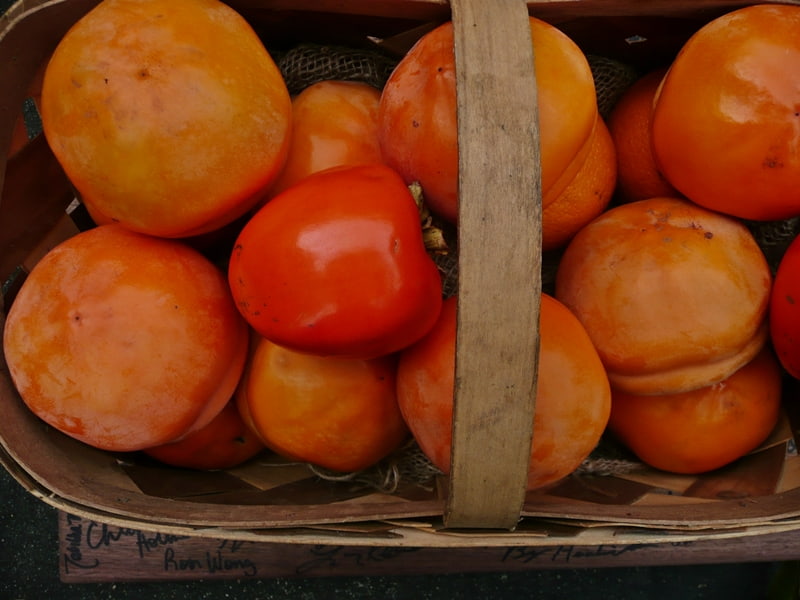
I only have two Oriental persimmon trees, and they aren’t overly large (maybe 10 or 12 feet tall), but they are absolutely loaded. I would guesstimate a couple of bushels of the apple-sized fruit on each tree, and when you realize that’s all persimmon pulp (they don’t have seeds like their wild kindred), that translates to the potential for a lot of good eating. I’ll have to harvest them soon, since just today I noticed some kind of critter had been snacking, but fortunately they ripen quite nicely even if picked a bit green. Like its wild relative, one of the two will turn you inside out and draw your mouth into a pucker which looks like someone who just swallowed his dentures. The other can be eaten when still firm, but I let both ripen until they are so soft they are almost jelly-like in consistency. Fortunately the pulp freezes nicely, so in addition to enjoying fresh ones for a short time there are lots of persimmon-based desserts in the offing. Here are two favorites. Take note, both are rich and the pudding incredibly so.
PERSIMMON PUDDING
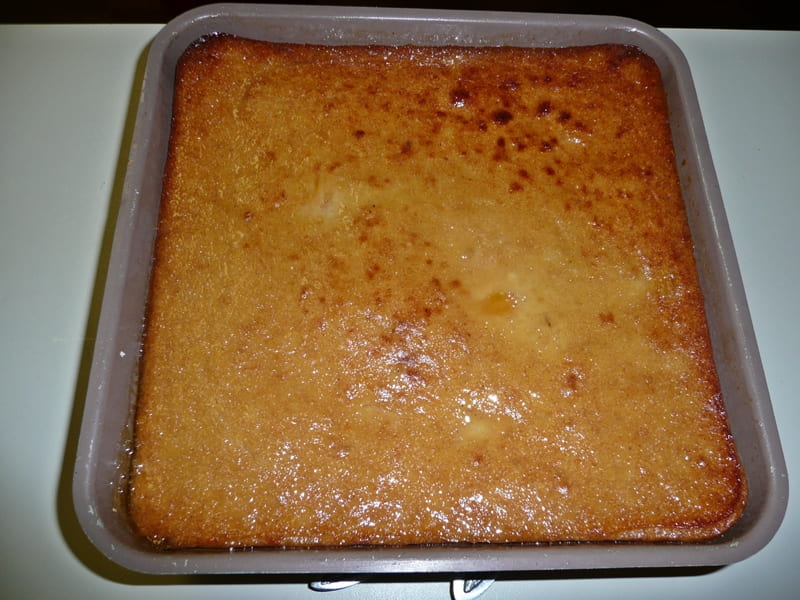
There are numerous persimmon pudding recipes. You can Google James Beard’s version and it’s a dandy, but here’s one which is a bit different inasmuch as it uses wine in the making of the batter.
2 cups sifted flour
1 teaspoon salt
½ teaspoon cinnamon
½ teaspoon baking soda
½ teaspoon nutmeg
2 heaping cups persimmon pulp
1 ½ cups sugar (you can substitute honey or molasses)
1 ½ cups muscadine wine or any sweet wine
3 large eggs
¼ cup whole milk
3 tablespoons melted butter
Mix the dry ingredients together and then stir in the persimmon pulp, wine eggs, milk and melted butter. Pour into a buttered 8X8 pan and bake at 300 degrees until done. Allow to cool before cutting into small squares for serving. Goes nicely with a hard brandy sauce, whipped cream, or lemon sauce.
PERSIMMON BREAD
Pumpkin bread has long been a favorite of mine, but all things considered I’ll take persimmon bread over it every time. Here’s a recipe for a persimmon loaf.
2 cups sifted flour
½ cup whole milk
2/3 cup sugar (use brown sugar if you wish)
1 large egg
4 tablespoons shortening or lard
1 cup persimmon pulp (finely chopped, although in truth when fully ripe persimmon pulp is almost jell-like in consistency)
1 cup black walnuts
1 tablespoon vanilla extract
1 teaspoon cinnamon or allspice
Mix thoroughly and place in a greased bread pan or tube pan and cook for 45-50 minutes at 350 degrees. Use a toothpick to make sure the bread is done.
********************************************************************************
THIS MONTH’S BOOK SPECIALS
This month’s specials are in keeping with the season and developments described above in “Jim’s Doin’s.” Deer season is upon us, and hopefully many of you will soon have venison in the freezer thanks to successful hunting or the graciousness of friends. If not, by all means get in the woods if at all possible. If not, a spot of armchair adventure is never amiss, and both of this month’s offerings relate to the deer hunting experience.
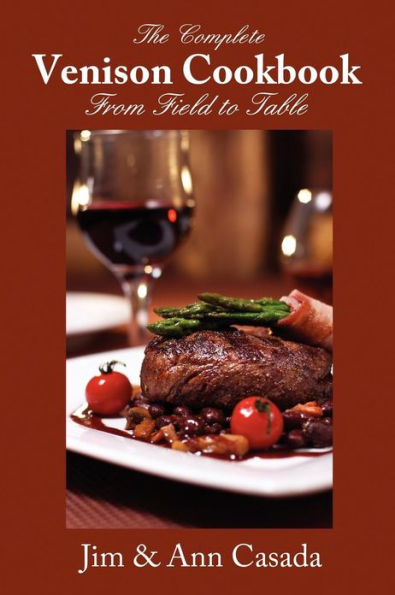
The first is the award-winning cookbook Ann and I wrote fairly early on in our venture into the world of putting together recipes and stories, The Complete Venison Cookbook. It contains scores of recipes, most of them the essence of simplicity (I’m not much into fancified culinary creations); along with details on dressing, processing, and aging deer; the health benefits of venison; and more. It is on special for $10 postage paid.
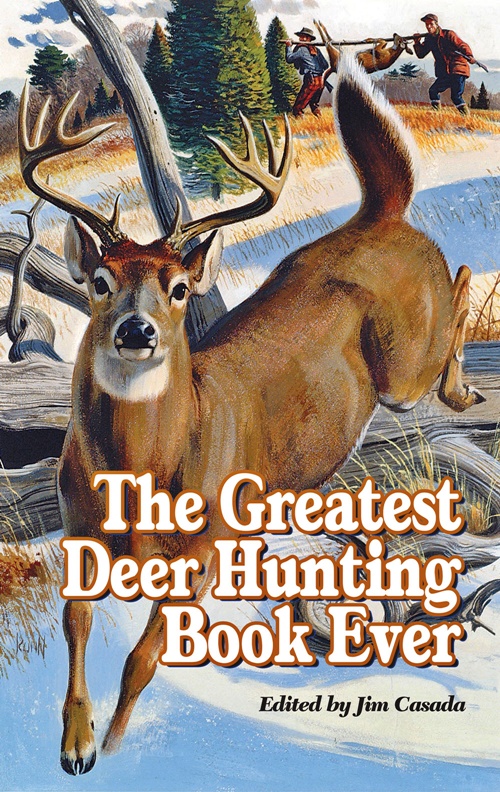
The second offer is for the trade edition of The Greatest Deer Hunting Book Ever. It is a beautifully bound hardback with dust jacket running to more than 450 pages and featuring many of the finest, most enduring whitetail stories ever told. Also included are my Introduction, an essay on the sport’s literature, editorial comments on each of the selections, and some fine art work by Ron Van Gilder. It is only $30 postage paid, and if you want to get a read and eat combo (think Christmas gifts for deer hunting buddies) I’ll offer this book and the cookbook for $38 postage paid. Of course I’m always happy to sign and inscribe books if you so desire.